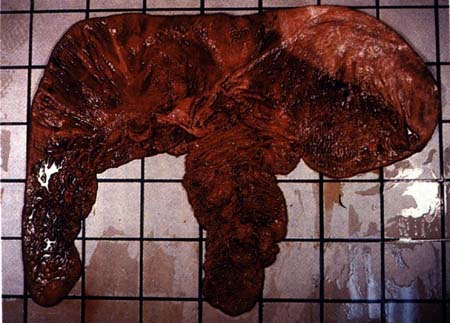By Dr. Karen Wolfsdorf, DVM
Mares can develop problems during pregnancy or be at high risk of losing the pregnancy for a variety of reasons. These include age (old mares frequently have endometriosis in which the uterus is unable to properly supply the fetus with appropriate blood supply and nutrients), physical conditions (placental and fetal fluid abnormalities; body wall tears; chronic debilitating conditions such as laminitis and Cushing’s disease), and acute disease or injury (placentitis, uterine torsion, surgical colic, colitis, acute laminitis, or fractures).
When a mare becomes stressed or debilitated, inflammatory chemicals and prostaglandins increase and induce abnormal uterine contractions and potential pregnancy loss. Reproductive problems that arise during gestation, however, when detected and diagnosed early, can still result in the survival of the mare and usually the foal. The abnormalities most commonly seen during the middle to late stages of pregnancy will be discussed in this article.
Uterine torsion
Uterine torsion is an infrequent complication of pregnancy, reported in 5% to 10% of all mares that have serious equine obstetric problems. Uterine torsion occurs in middle to late gestation and causes great risk to both mare and foal. The cause is unknown, although it has been postulated that uterine torsion may develop secondary to rolling as a result of gastrointestinal problems or trauma, or the righting reflexes and vigorous movements of the fetus, during the later stages of gestation. Severity of signs is dependent on degree of rotation, level of vascular or fetal compromise, and intestinal involvement. Torsion of the uterus greater than 360º interferes with blood flow to and from the uterus and can result in local oxygen deprivation, congestion, fetal death, and rupture of the uterus.
Physical examination can be within normal limits, with the problem evident only on rectal palpation of the broad ligaments transrectal and transabdominal ultrasonography can aid in assessment of uterine compromise by enabling determination of uterine wall thickness, placental integrity, vascular distension, fetal viability, and condition of the fetal fluid. If there is concern about intestinal involvement, abdominocentesis (a surgical puncture of the abdomen by a needle to withdraw fluid) may be performed to aid in determining the appropriate mode of replacement or prognosis.
Many methods have been used to correct uterine torsion in the mare. The most common are rolling the anesthetized mare and laparotomy via standing flank or ventral midline incision. Once the uterine position has been corrected, continued monitoring of the mare (for systemic compromise such as laminitis) and monitoring of fetal viability, blood progesterone and estrogens, placental edema and separation are essential to provide a realistic prognosis.
Placental hydrops
Hydroallantois (a sudden increase in the volume of allantoic fluid during a period of 10 to 14 days) is more common than hydroamnios (an excessive accumulation of amniotic fluid in the amniotic cavity). Hydroamnios, unlike hydroallantois, develops gradually over several weeks to months during the second half of gestation. It is often associated with a deformed fetus with a facial, genetic, or congenital abnormality. The pathophysiology of hydro-allantois in the mare remains unknown. Some authors have suggested that the increase in fluid is a placental problem caused either by increased production of fluid or decreased transplacental absorption. Others have proposed that the cause is related to placentitis and heritability.
Hydroallantois and hydroamnios
In both hydroallantois and hydroamnios, mares present with abnormally increased abdominal distension for the duration of gestation. Mares in advanced stages of hydropic conditions may have evidence of ventral abdominal wall herniation or prepubic tendon rupture. Early management is aimed at preventing these body wall tears, which improves the mare’s prognosis, since obtaining a live foal has not been reported with hydroallantois and has been reported only once with hydroamnios... To read the complete article you need to be a subscriber
CLICK HERE TO SUBSCRIBE TO BREEDING NEWS
SUBSCRIBERS CAN READ THE COMPLETE ARTICLE BY LOGGING IN AND RETURNING TO THIS PAGE




